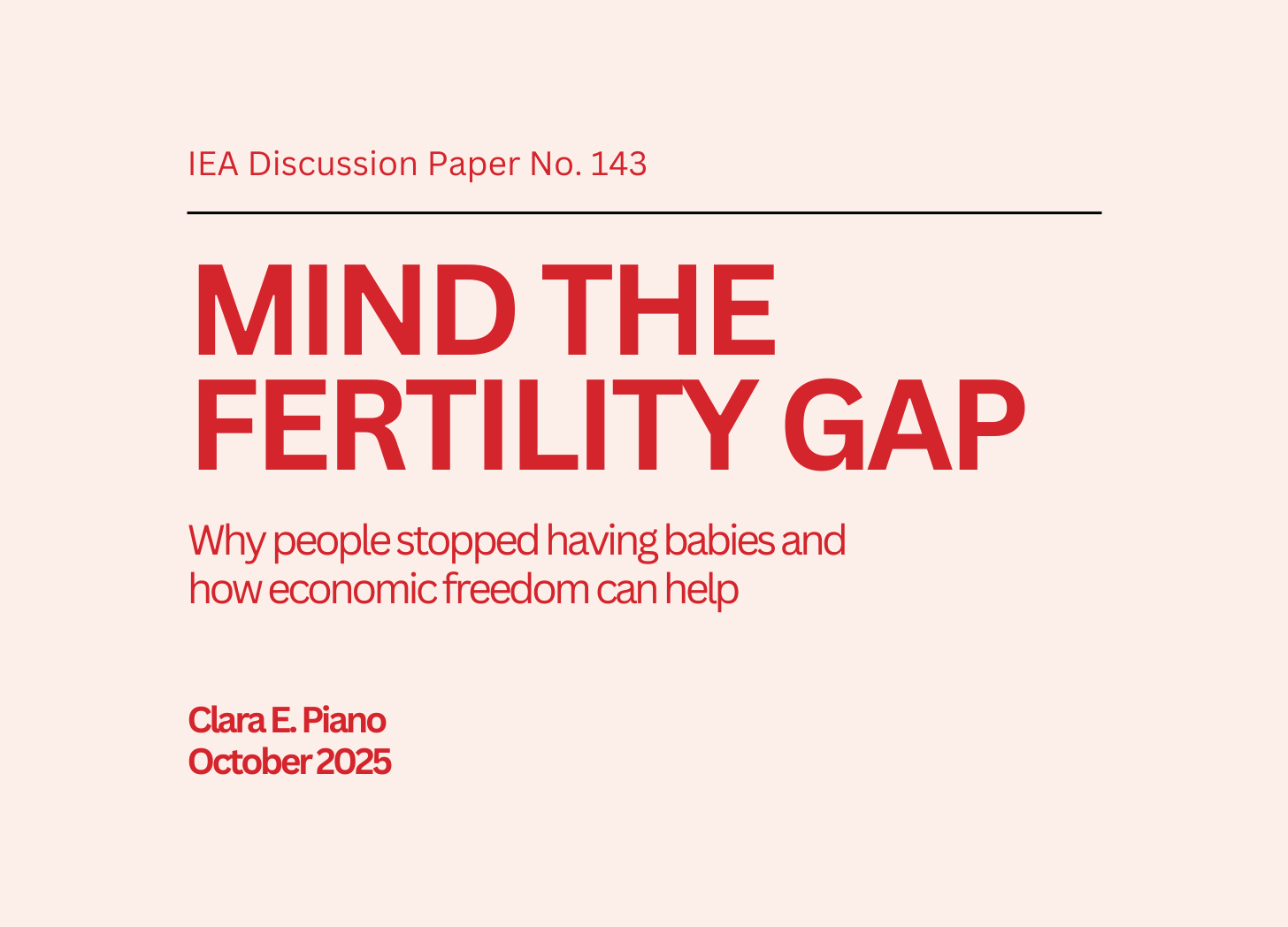Mind the Fertility Gap
Why people stopped having babies and how economic freedom can help
by Clara E. Piano
British women are falling at least 0.4 children short of their own stated family goals, according to fertility data through 2011, with this gap likely widening as fertility now hits record lows of 1.44 while desired family size remains stable at 2.2
New report shows how pro-natal policies that focus on cash incentives, such as baby bonuses, subsidies, and maternity pay, may have some short-term effect but are often found wanting and prohibitively expensive
Evidence shows policies affecting economic freedom, including labour market, childcare and housing liberalisation, can have profound effects on fertility through their impact on work-family compatibility
A new paper, published today by the Institute of Economic Affairs, shows that while the total fertility rate hit a record low of 1.44 children per woman in 2023, women’s intended fertility has remained remarkably stable at around 2.2 children since 1979, suggesting that the ‘fertility gap’ may have grown since it was last measured in 2011.
The report, ‘Mind the Fertility Gap: Why people stopped having babies and how economic freedom can help’, examines the evidence on the best way to close the fertility gap and tackle falling birth rates. It finds that while ostensibly pro-natal policies focused on cash transfers can result in more children, financial incentives have limited success, do not address the root causes of birth rate declines, and are prohibitively costly for most governments.
Instead, research shows traditional pro-natal policies, such as baby bonuses and parental leave, yield near-zero effects on long-run fertility decisions. Instead, evidence from the United States shows that states with greater economic freedom - especially in labour market regulation - tend to have smaller fertility gaps. Work-family compatibility emerges as a crucial constraint, with flexible labour markets naturally providing parents with more options to customise work schedules around family goals.
Economic freedom shows strong associations with smaller fertility gaps. New research analysing US state-level data reveals that housing and land use regulation significantly impacts family formation. Spacious, affordable housing with multiple bedrooms is what economists call a “child-complement” - couples have higher fertility when they can achieve these conditions.
Yet extensive land use regulations dampen housing supply responses and keep prices artificially high, making the costs of raising children higher than necessary. Studies show a significant negative relationship between land use restrictions and fertility rates, with effects especially concentrated among women in their twenties. Similarly, seemingly minor regulations can have outsized anti-natal effects - stringent car seat requirements in the US reduced total births by 145,000 since 1980 by indirectly requiring families to purchase larger vehicles when going from two to three children.
Dr Clara E. Piano, report author and Visiting Assistant Professor of Economics at the University of Mississippi, argues that the fertility gap represents a growing failure to achieve family goals rather than a decline in the desire for children. If women achieved their stated fertility intentions, the UK’s fertility rate would rise well above the United States (1.62) and nearly every other high-income country.
Piano makes the following key recommendations to help close the fertility gap:
Labour market deregulation: Remove rigid regulations that prevent flexible working arrangements, remote work, and independent contracting. Evidence from US states shows that more flexible labour markets are strongly associated with smaller fertility gaps, allowing parents to balance careers with family life rather than being forced to choose between them.
Housing and planning reform: Reduce land use and housing regulations that keep prices artificially high and restrict housing supply. Spacious, affordable housing with multiple bedrooms enables couples to achieve higher fertility, yet current planning restrictions make the costs of raising children unnecessarily expensive.
Reform anti-natal public programmes: Audit and reform public pension systems and other welfare programmes that inadvertently punish parents. Parents currently bear all the costs of raising the next generation of taxpayers while the benefits are spread across society.
Support religious liberty: Allow religious organisations to freely promote pro-natal messages and create supportive communities around parenthood, rather than attempting ineffective and often expensive Government campaigns. International evidence shows this approach can increase fertility at virtually no cost.
Avoid ineffective policies: Resist calls for expensive baby bonuses, cash incentives, and subsidized childcare schemes, which research shows have minimal long-run impact on fertility decisions and fail to address the root causes of declining birth rates.
Piano also suggests some creative solutions to closing the fertility gap, including giving children political representation by allowing parents to cast proxy votes on behalf of their minor children. This would ensure children’s interests are represented in policy decisions and create a sustainable feedback mechanism where parents themselves signal which barriers to family formation matter most.
The paper warns that without action, the UK faces mounting fiscal pressures, labour shortages, and a growing population of people unable to achieve their stated family goals.
Dr Clara E. Piano, report author and Visiting Assistant Professor of Economics at the University of Mississippi, said:
“Restricting the term pro-natal to explicit transfer policies obscures the broader policy landscape that shapes family decisions. Policies affecting economic and religious freedom, in particular, have profound effects on fertility through their impact on work–family compatibility and personal beliefs.”



